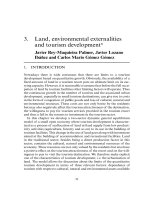THE ECONOMICS OF MONEY,BANKING, AND FINANCIAL MARKETS 485
Bạn đang xem bản rút gọn của tài liệu. Xem và tải ngay bản đầy đủ của tài liệu tại đây (50.79 KB, 1 trang )
CHAPTER 17
Tools of Monetary Policy
453
INSIDE THE CENTRAL BANK
Monetary Policy at Times of Crisis
At times of turmoil in financial markets, central
banks face a number of challenges. In the
Canadian case, for example, challenges involve
keeping the overnight rate near the policy rate,
keeping spreads in the term interbank market
low by influencing interbank term rates, and
deciding how to respond to the potential macroeconomic effects of the crisis by changing the
monetary policy stance (that is, the target and
operating band for the overnight rate).
Against the backdrop of the recent turmoil in
financial markets, the Bank of Canada faced
widening spreads and increased volatility in the
term interbank market and took extraordinary
measures to stabilize the financial system. In its
efforts to influence interbank term rates, the
Bank introduced term PRAs and increased the
frequency and size of its discretionary liquidity
operations. Moreover, the Bank expanded its list
of acceptable collateral (for both its standing
lending facility as well as for its term PRA operations) to include bank-sponsored asset-backed
commercial paper and U.S. Treasuries.
These discretionary liquidity operations do
not represent a change in the stance of monetary policy. However, in order to support the
Canadian economy, the Bank of Canada, acting
in concert with other major central banks, also
changed its policy stance by lowering the target
and operating band for the overnight interest
rate in a series of announcements. In fact, in the
first ten months of 2008 alone, the policy rate
was reduced by 300 basis points to 1.5% by the
end of 2008 and then to 0.25% by April 2009.
Moreover, the Bank is now considering quantitative measures of monetary policy, and has
identified alternative instruments that it would
consider using at the effective lower bound for
the overnight interest rate.
Overnight
Interest
Rate, i or
2
Bank rate, i ff
*
i or
ib
Rs
1
Rd2
0.50
Rd1
NBR
F I G U R E 17- 10
BR
Quantity of
Reserves, R
How the Standing Lending Facility Puts a Ceiling on the Overnight
Interest Rate
The rightward shift of the demand curve for reserves from R d1 to R d2 moves the equilibrium from
point 1 to point 2 where ior = ib and borrowed reserves incease from zero to BR.









